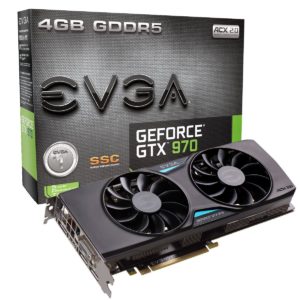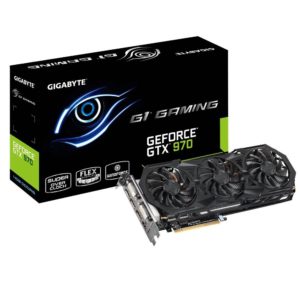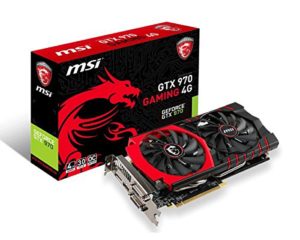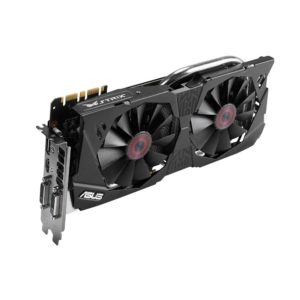Are you looking for the best GTX 970 card? You’re in the right place.

Time for a new GPU?
We’ve all experienced it. That moment your PC finally struggles to play the next-gen games. Or, if you work with video, you may start to experience painfully long rendering times. If that’s the case, then it’s probably time for a GPU upgrade.
Video cards can quite often be the most expensive component in a gaming PC or one built to handle multimedia tasks. A quick search online will reveal a massive range of video cards on the market. And for all but the most tech-savvy buyers, it is a highly confusing task.
We’ve helped to narrow your search and focused our reviews on the GTX 970 range. These cards are high performance, attractively priced, and will satisfy the graphical needs of even the most avid gamer. By the end of this article, you’ll have decided which one is the best GTX 970 card for you.
Best GTX 970 Cards – Comparison Table
| Image | Model | Price |
|---|---|---|
 | EVGA GeForce GTX 970 (Top Pick) | Check Price |
 | Gigabyte GeForce GTX 970 | Check Price |
 | MSI GAMING GeForce GTX 970 | Check Price |
 | ASUS STRIX GeForce GTX 970 | Check Price |
Gigabyte GeForce GTX 970 Card

Gigabyte has released an overclocked version of the GTX 970, which improves upon an already impressive card.
They’ve overclocked the GTX 970 by 128MHz more than what you get with the base clock, which is already relatively high at 1178MHz but now sits stable 1,329MHz.
Gigabyte attributes this to what they call “GPU Gauntlet Sorting.” EVGA does a similar thing with their range of SuperClocked cards and probably aren’t the only manufacturers to do this.
Gigabyte has also added extra power to the card, with a 6 + 8 pin configuration for their boards. The reference-clocked cards only offer a pair of 6 pin PCIe connectors.
They’ve drastically improved the cooling abilities of the GTX 970 by adding a Windforce triple-fan cooling system, making sure that the GPU isn’t overheating when performing under load.
With the super-cool operating temperature and colossal potential for overclocking, you can run the card at 1,500MHz without it even breaking a sweat. Under average load, the G1 Gaming was operating at 58 °c, and at 100% load, the hottest it got was only 64 °c and remained almost silent throughout the whole process.
It is marketed as having 4GB of memory, although it only offers 3.5GB of GDDR5. That doesn’t impact performance. As we mentioned before, RAM isn’t a huge concern unless you’re running multiple high-resolution monitors or a large 4K display.
These features give the Gigabyte GeForce GTX 970 some desirable performance numbers, especially when considering the price.
This card is remarkably close to the next tier up, the GTX 980, and may leave you wondering whether or not the higher-tier card is even worth the money. It is the quicker card, but not by as much as you’d think.
The G1 Gaming will make your rig into a gaming powerhouse and won’t turn it into a dry sauna after playing Battlefield 1 for a couple of hours, but we all know how easy it is to get carried away.
Your PC won’t sound like an airplane about to take off, either.
Pros
- 8-pin and 6-pin power connection for greater overclocking headroom
- Great performance for the price – better value for money than the significantly more expensive GTX 980
- Flawless 1080p and 1440p gaming
- It runs very coolly even when under load
- Incredibly quiet fans
- Low power consumption – the manufacturer recommends a 550w minimum power supply.
- It comes with a backplate to protect the backside of the PCB.
Cons
- When under 100% load, there may be some audible coil whining, although this has been reported to stop after the card has been used for a while.
- The card is very long and may not fit in all cases
MSI GeForce GTX 970 Card

MSI have built a custom board that offers extra overclocking headroom compared to the reference design, with a 6 + 8 pin configuration. The GPU base clock is at a stable 1140 MHz with a 1279 MHz boost frequency.
The memory offered is the same as in the reference design – 4 GB of GDDR5 memory ticking away at 7010MHz, which will play games flawlessly at 1080p on high-max settings.
MSI have compromised with the number of display connectors on the card. You’ll get one full-size HDMI 2.0 port, one full-size Display Port connector, and two DVI connectors.
Although many people have marked the graphics card down on account of having fewer connectors, there’s more space to vent hot air out of the chassis efficiently.
The power consumption is a little lower than that of the G1 Gaming card. The manufacturer requires a 500-watt power supply unit if you’re using a single card or an 800-watt power supply if using the cards in 2-way SLI – GeForce’s way of saying pairing two cards together.
Two Torx fans with dispersion blades help keep the card operating at ten °C cooler at maximum fan speed than the Twin Frozr 4 design. These fans blow air through the heat sink and exhaust it around the card.
The heat sink covers 90% of the fans’ diameter, and there are four nickel-plated copper heat pipes, a super SU heat pipe, and three additional heat pipes running through the contact plate to improve heat dissipation.
And the MSI GeForce GTX 970 card is excellent at managing heat dispersion. When idle, the card recorded 29°C as the highest temperature.
Anything below 50°C is considered acceptable. Anything below 40°C is considered good. So with that in mind, the MSI GeForce GTX 970 is an incredibly cool card.
Under maximum load, the hottest temperature – not average – the card reached was 68°C, which matches the Gigabyte GeForce GTX 970.
The MXI GeForce GTX 970 is a formidable graphics card with specs that nibble on the heels of the GTX 980. Not only will this card keep very cool under pressure, it only produces 39dBA of noise when gaming, which is practically silent for a card of this performance.
Pros
- Includes disc with MSI gaming app for easy overclocking
- Excellent heat dissipation
- Flawless 1080p and 1440p gaming
- Runs quiet – only 39dBA under load
- Cool operating temperatures – 29°C idle and 68°C under maximum load
- Low power consumption – the manufacturer recommends a 500w power supply for a single card or an 800w power supply for a two-card SLI
- It plays games flawlessly on max settings at 1080p.
Cons
- Lack of display connectors compared with other cards
EVGA GeForce GTX 970 Card (Editor’s Choice)

EVGA have released a number of different build version of the GTX 970 card and there are currently 9 different versions on Amazon. They all offer 4GB of GDDR5 memory.
The main differences between the cards are the clock speeds and cooling methods.
Considering the price and the features offered, the EVGA GeForce GTX 970 SC ACX 2.0 offers the best value for money, giving superior clock speeds and a water cooling solution that keeps the card operating at seriously low temperatures, even under load.
There are a good bunch of options on Amazon, all with slightly different speeds and cooling methods, so it’s really about your priorities and what you want from a card.
Features
The super clocked version of EVGA’s GeForce GTX 970 has a 1165MHz base clock, which is substantially higher than the 1050MHz you get with the reference card. The 1317MHz boost clock is one of the highest we’ve seen from the factory overclocked GTX 970 cards.
EVGA’s card is cooled using two 87mm axial fans. They say that they have been focusing on fan power consumption and blade quality to lower fan temperatures by 26% and power consumption by 250% compared to a reference fan.
The cooling system has also been tweaked to generate 36% less noise.
The card includes two six-pin power inputs as well as dual SLI connectors. We can assume that the card supports triple – and even quad – SLI connections.
There’s a single DP 1.2 output, DVI-I and DVI-D outputs, and one HDMI 2.0 port for monitor connections.
When it comes to temperature, EVGA’s ACX 2.0 cooled cards stand head and shoulders above the rest of the competition. Operating at idle, the card only reached 23C and got up to 40C when gaming for over an hour.
While these cards are superior in terms of temperature, they are louder than the other cards in this review. We measured the sound level by placing a microphone with a wind cover 2 inches above the motherboard corner.
What we gathered was a 43.3dBA idle noise output and 46.3 when gaming for an hour. In a quiet room, you’re going to hear this card, even if only a little. If you have headphones or speakers on most of the time, this won’t be a problem.
When we tested the EVGA GeForce GTX 970 card, it used 103 Watts when operating at idle and 289 Watts at the peak while playing Battlefield 4 for over an hour. The manufacturer recommends a 500w or more significant power supply unit.
If the possibility of 23C idle and 40C intense gaming temperatures don’t excite you even a little bit, then the EVGA GeForce GTX 970 SC isn’t for you. If you can handle a warmer operating temperature, you can enjoy higher clock speeds with the EVGA GeForce GTX 970 SSC.
Pros
- Watercooled cards have very low operating temperatures.
- Flawless 1080p and 1440p gaming
- EVGA GeForce GTX 970 4GB FTW+ has a 1367MHz boost clock – the highest of any card on this list
- Low power consumption
- Fans have been tweaked to draw less power and generate less heat.
- Different builds tailored to different users
Cons
- Louder under load than the other cards mentioned on this list
ASUS Strix GeForce GTX 970 Card

ASUS have released an impressive version of the GeForce GTX 970, featuring a 6-phase power design for the GPU and memory. They claim that their DIGI+VRM with Super Alloy power design generates 30% less noise and has 2.5x more durability than the reference card design.
As with the other cards on the list, we get 4GB of GDDR5 memory.
With a 114 MHz base clock, 1253 MHz boost clock, and 7012 memory clock, it doesn’t blow away other factory overclocked GTX 970 cards, but it does offer a substantial increase to the reference 970. ASUS have changed the display ports from the reference design and offer a DVI-D, DVI-I, HDMI 2.0, and DP 1.2 port.
The ASUS Strix GTX 970 is a dual-slot card. Large heat pipes are coming out from both the bottom and the top of the card to aid heat dissipation. Adding to the custom design from ASUS, we now have a single eight-pin connector instead of dual six-pin PCI-E connectors.
When idle, the card was consuming 95W and 237W under load. A 450W power supply will provide more than enough power for a single card.
It follows the same design as the other ASUS Strix range of cards, with a dual-fan cooling solution that features ASUS’s 0dB technology. The fans won’t turn on until the GPU reaches a specific temperature. So, if you’re only doing some light computing or even playing some less graphically demanding games, then your card will be silent.
Breaking the cooling solution down, it consists of two large aluminum heat sinks, two smaller heat pipes, and one larger heat pipe. All three copper pipes make direct contact with the GPU.
When the PC was running for 15 minutes with only the desktop screen loaded, the highest temperature we recorded was 38C.
While gaming for an hour, the card reached 66C and ran Furmark for 15 minutes under average load. Under extreme load, the card only climbed to 68C. That is impressive, considering that it’s normal to see cards of this spec reach 80C and over when running Furmark.
Similar to the EVGA GTX 970, the noise levels measured at 45dBA under load. You’ll be able to hear it if gaming in a silent room with no headphones or speakers on, but who does that? If you’ve got any background noise, you won’t be able to hear the ASUS Strix even when gaming.
When tested, we consistently experienced 90fps and over on 1080p games set to ultra, over 50fps when playing at 1440p on high to very high, and over 32fps when playing games at 4K at normal or high with some of the advanced settings turned off.
Pros
- Great value for money
- Flawless 1080p and 1440p gaming
- Includes backplate
- Low power consumption
- Very quiet even when gaming
- Silent operating when not under load
- Significantly improved efficiency compared to the reference card.
Cons
- Provides a slim performance bonus compared to the reference card
How to Shop for the Best GTX 970 Card
Things to consider:
Model Number
This is the most crucial indicator of the performance of a graphics card. The model number represents three critical pieces of information – the graphics processor, clock rates, and memory bandwidth.
An overclocked lower model may have superior RAM and look impressive to those who don’t know what to look for, but you can bet that it will be outperformed entirely by the next generation card’s base model.
When you’re buying a card for gaming, you should buy the highest-tier graphics card your budget allows.
You should never really need to spend more than $350 to get a blazing fast card that can run all the latest releases at high quality with ease. And investing a little more now will mean you won’t have to upgrade for a few generations, saving you money in the long run.
Memory and Bandwidth
Most people would have you believe that the more memory, the better. However, that’s not always the case. Bandwidth is a far more accurate gauge of performance. Choosing a graphics card based on memory is like choosing a car based on its fuel tank size.
Unless you’re running multiple monitors simultaneously or have a huge 4K display, you won’t need to worry about RAM. If you’re playing or working at 1080p, you’ll be looking for a higher-end graphics card anyway, which will come with more RAM as standard.
Instead of paying attention to the amount of RAM a card offers, look at the bandwidth. While it will vary depending on the graphics card’s performance tier, remember that GDDR5 provides twice the bandwidth as DDR3 memory at the same clock rate. For example, 1GB of GDDR5 is worlds better than 4GB of DDR3.
Bandwidth is a huge performance bottleneck, so when possible, always choose the graphics card with the highest bandwidth.
Your Platform – Know Its Limits
While the graphics card is arguably the most crucial part of a gaming PC and one built to perform graphically intense multimedia tasks, it’s essential to know your current platform’s limitations.
If you’re running an older dual-core Celeron, Sempron, or Pentium processor, for example, then it won’t be able to keep up with the latest graphics cards, and buying one would be a waste of money. Instead, opt for a mid-range graphics card, or upgrade your processor to handle modern graphics cards.
The display you are using is another factor. You don’t need the most expensive graphics card if you’re running a 1280×1024 monitor. On the other hand, if you’re gaming in 3D or running several 1080p monitors in surround, then a mid-range card won’t be able to provide the framerates you want for smooth gaming.
Pairing Multiple Cards Isn’t Always Best.
AMD and Nvidia allow you to pair up multiple graphics cards together. It is called CrossFire if you’re using Radeon cards or SLI if you’re with GeForce.
While it does offer an increase in performance, a second graphics card won’t double performance, as you may expect. Instead, you’ll be looking at an increase of 25-50%.
The performance increase factor decreases as you add more cards. Using several cards can lead to inconsistencies, micro stuttering, increased power consumption, and much more noise.
If you’re running a single monitor, pairing multiple cards is unnecessary, and you will be far better off buying a single high-spec card. Those who run a large 4k display or multiple high-resolution monitors should look at pairing graphics cards for optimal performance.
Compatibility
You open your PC up, and you’re about to install the new graphics card. Except it doesn’t fit.
Before buying a new card, make sure that it will fit inside your PC and that the power supply can provide enough juice. Please consider how many six and eight-pin PCIe power connectors it has, how many watts it is rated for, and how many amps it supplies along the 12v rails.
Please take this information and check it against the graphics card specs. If your PC can’t handle the new graphics card, buy a less power-demanding model or consider a power supply upgrade.
Now you’ve determined what kind of graphics card you’re looking for and what your PC can handle, let’s take a look at some of the best graphics cards in the GTX 970 series.
Verdict – What is the Best GTX 970 Card?
The GeForce GTX 970 reference card is already a fantastic choice, offering surprising performance specs that nibble on the heels of the significantly more expensive GTX 980.
The factory overclocked builds in this article will perform flawlessly when gaming at 1080p and 1440p, even at 4K with some advanced settings turned down. But there can only be one GTX 970 card that takes the title…
EVGA GeForce GTX 970 SC
The EVGA GeForce GTX 970 SC offers excellent value for money when considering the reference card design improvements.
With a competition icing operating temperature and one of the highest boost clock speeds on the list, you’ll be able to game all night without your card even breaking a sweat.